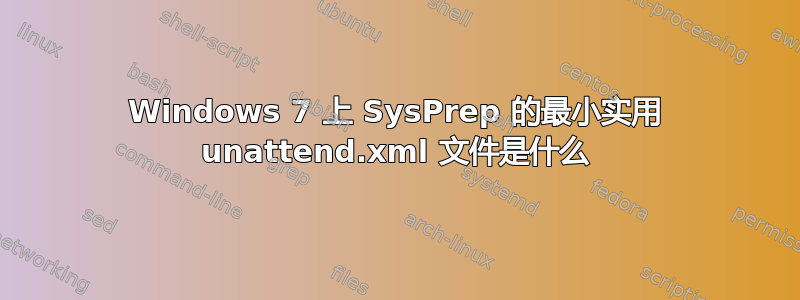
您能否提供一个在 Windows 7 中使用的最小unattend.xml文件,该文件将在一个工作站上手动安装、更新和配置,然后 SysPrep 将像这样运行:
C:\Windows\System32\sysprep>
sysprep /generalize /oobe /unattend:unattend.xml /shutdown
然后C:将分区克隆到多个工作站(我使用partimageLinux LiveUSB 来实现这一点)。
这unattend.xml应该配置工作站,使其在克隆后不会要求输入任何内容。工作站应该只显示一个普通的登录屏幕,其中有之前配置的帐户。它应该创建随机计算机名称,并且不会尝试加入 Active Directory,因为我不习惯将密码存储在 中unattend.xml。
我不想使用 Windows 自动安装工具包 (Windows AIK) 中的 Windows 系统映像管理器 (Windows SIM),因为这太过分了 — — 对我来说太复杂了。
答案1
<?xml version="1.0" encoding="utf-8"?>
<unattend xmlns="urn:schemas-microsoft-com:unattend"
xmlns:wcm="http://schemas.microsoft.com/WMIConfig/2002/State"
xmlns:xsi="http://www.w3.org/2001/XMLSchema-instance">
<settings pass="generalize">
<component name="Microsoft-Windows-PnpSysprep"
processorArchitecture="amd64"
publicKeyToken="31bf3856ad364e35"
language="neutral" versionScope="nonSxS">
<PersistAllDeviceInstalls>true</PersistAllDeviceInstalls>
</component>
</settings>
<settings pass="specialize">
<component name="Microsoft-Windows-Deployment"
processorArchitecture="amd64"
publicKeyToken="31bf3856ad364e35"
language="neutral" versionScope="nonSxS">
<RunSynchronous>
<RunSynchronousCommand wcm:action="add">
<Description>Disable create user account</Description>
<Path>reg add HKLM\Software\Microsoft\Windows\CurrentVersion\Setup\OOBE /v UnattendCreatedUser /t REG_DWORD /d 1 /f</Path>
<Order>1</Order>
</RunSynchronousCommand>
</RunSynchronous>
</component>
<component name="Microsoft-Windows-Shell-Setup"
processorArchitecture="amd64"
publicKeyToken="31bf3856ad364e35"
language="neutral" versionScope="nonSxS">
<RegisteredOwner>Wile E. Coyote</RegisteredOwner>
<RegisteredOrganization>ACME Corp.</RegisteredOrganization>
<TimeZone>Central European Standard Time</TimeZone>
<Computername>*</Computername>
<OOBE>
<HideEULAPage>true</HideEULAPage>
<NetworkLocation>Other</NetworkLocation>
<ProtectYourPC>2</ProtectYourPC>
<SkipUserOOBE>true</SkipUserOOBE>
</OOBE>
</component>
</settings>
<settings pass="oobeSystem">
<component name="Microsoft-Windows-International-Core"
processorArchitecture="amd64"
publicKeyToken="31bf3856ad364e35"
language="neutral" versionScope="nonSxS">
<InputLocale>pl-PL</InputLocale>
<SystemLocale>pl-PL</SystemLocale>
<UILanguage>pl-PL</UILanguage>
<UserLocale>pl-PL</UserLocale>
</component>
</settings>
</unattend>
你只需要改变:
<RegisteredOwner><RegisteredOrganization><TimeZone>- 将波兰语区域设置
pl-PL为您的区域,例如en-US美国。
答案2
你可以让它无需密码即可加入域不安全加入。
答案3
超级用户中有一个类似的问题: Sysprep 无需创建新用户
作为参考,这里是发布在那里的最小 unattend.xml 文件:
<?xml version="1.0" encoding="utf-8"?>
<unattend xmlns="urn:schemas-microsoft-com:unattend">
<settings pass="oobeSystem">
<component name="Microsoft-Windows-Shell-Setup" processorArchitecture="amd64" publicKeyToken="31bf3856ad364e35" language="neutral" versionScope="nonSxS" xmlns:wcm="http://schemas.microsoft.com/WMIConfig/2002/State" xmlns:xsi="http://www.w3.org/2001/XMLSchema-instance">
<OOBE>
<SkipMachineOOBE>true</SkipMachineOOBE>
<SkipUserOOBE>true</SkipUserOOBE>
</OOBE>
</component>
</settings>
</unattend>
您可以将其复制并粘贴到记事本中,并将其保存为“unattend.xml”(带引号 - 因此文件扩展名将为 xml)。致谢布莱尼尔。


